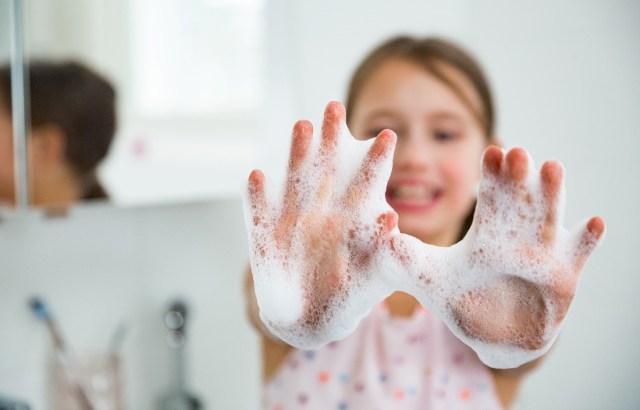In the U.S., flu season is typically October through May, with peak flu activity from December to March. This is a familiar cycle parents navigate with their kids annually. However, this season of sniffles might be a little different, with the possibility of what experts are calling a “twindemic,” the combination of a severe flu season alongside COVID-19.
While parents may understand how to prevent the spread of COVID-19 and the flu, it can be difficult to find the right words to explain such precautions to young kids. Thankfully, it is doable!
Here are three tips from The Goddard School’s team of early childhood health and education experts to help keep these discussions cheerful, along with six indoor activities to make quarantine time fun, engaging and educational:
1. Make Healthy Habits Fun
- Remind your child that handwashing is a great way to stay healthy, clean and safe. Have them scrub their hands to the tune of “Happy Birthday” to ensure proper timing. Washing hands as a group makes for additional fun.
- Teach kids about keeping themselves and each other safe. Share guidelines about wearing masks and social distancing. This may mean that the “big kids” (older than 2-years-old) should wear masks if they are able. Coach them on how close or far apart to sit when indoors or outdoors. Make it a game by having kids help set up chairs in the appropriate arrangement. For some added imagination, throw a few blankets over the chairs to create a fun and socially distanced fort!
2. Talk about Quarantine
- Quarantine can be a tough concept for young children to grasp. Remind them that sometimes teachers and friends might need to stay home to get better. And if someone in your family gets sick, explain to your child why that person is staying home. While it may be a given for you, help tie the two things together for them.
- Ensure the conversations are easy for young children to understand. Simply explain that staying home gives them a chance to rest and get well enough to be reunited with their friends.
- Above all, keep conversations with kids about illness, COVID-19, quarantine and the like upbeat and foster a feeling of safety and protection.
3. Teach Your Child to Be Honest about How They’re Feeling
- Kids may want to stay silent if they don’t feel well to avoid getting sent home and be away from their friends. Who can blame them? It’s helpful to point out that going home sooner may help them feel better faster while lessening the chance of their friends getting sick.
- It’s important to teach kids there’s no shame in feeling sick and help them feel comfortable telling teachers or other grown-ups. Be sure to keep the mood supportive and nurturing. This will help them open up, and in the long run, help everyone have less of a chance of getting sick.
4. Keep Young Minds Engaged with Indoor Activities
Whether homebound due to quarantine or just stuck inside on a cold afternoon, here are six indoor activities to keep your little one entertained while supporting their learning:
Puzzles: Puzzles are a great way to learn how to solve a problem. As your child works on puzzles, they develop self-regulation and concentration. Kids can also make their own by gluing pictures on paper and then cutting the paper into 6-12 pieces.
Cooking: Follow a recipe or create your own! Have your child engage in planning, collecting the ingredients and tools, measuring and mixing. All these activities support math, science and execution function skills such as planning and organizing. Most of all, it’s a fun way to connect with your child and enjoy what you made.
Fun Science: Simple science experiments can be a fun way to your child. For example, try the classic volcano. It’s messy but a lot of fun! To start, cover a soda can or bottle with paper and clay, leaving a hole at the top. Let the clay dry. Add about one cup of vinegar and a tablespoon of dish soap into the can. Wrap a tablespoon of baking soda in a bit of paper towel and push it into the can. When the paper breaks down, the volcano will erupt!
Child Games: Learning to take turns, counting and vocabulary development are just some of the skills kids build when playing simple board games. Get out the classics such as Candy Land, UNO for Juniors and Chutes and Ladders, and prepare for lots of giggles. You can also play games such as Under the Cups or Simon Says. Under the Cups is simple—as your child watches, place one bean under one of three cups. Move the cups around. Can your child guess where the bean is?
Creative Fun: Get out the art supplies and let your child create. You can add to the fun with special projects such as building a tower challenge (who can go the highest without it falling) or sending secret messages on paper. Your child can write a message in white crayon on paper. Then use watercolor paint and brush on the paper. Surprise, the message is revealed!
Reading: Reading together is very powerful. The experience strengthens the bond with your kids, builds their vocabulary and language skills, supports brain development, teaches life lessons through conversations about the characters in the stories and so much more. It is magical what a few moments spent with a book can do at each stage of life.
Here are a few book suggestions from Goddard’s Life Lesson Library that are designed to support emotional development and inspire on indoor days:
Infants—Toddlers:
- I Like Myself! By Karen Beaumont, illustrated by David Catrow
- Corduroy by Don Freeman
- We’re Going on a Bear Hunt by Michael Rosen, illustrated by Helen Oxenbury
Preschoolers—Kindergarteners:
- The Rabbit Listened by Cory Doerrfeld
- The Most Magnificent Thing by Ashley Spires
- My Friend is Sad by Mo Willems
